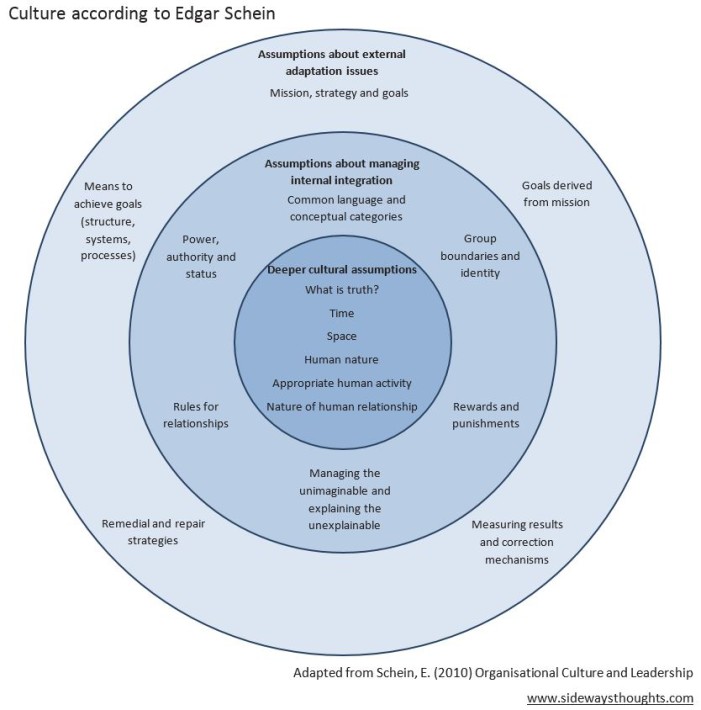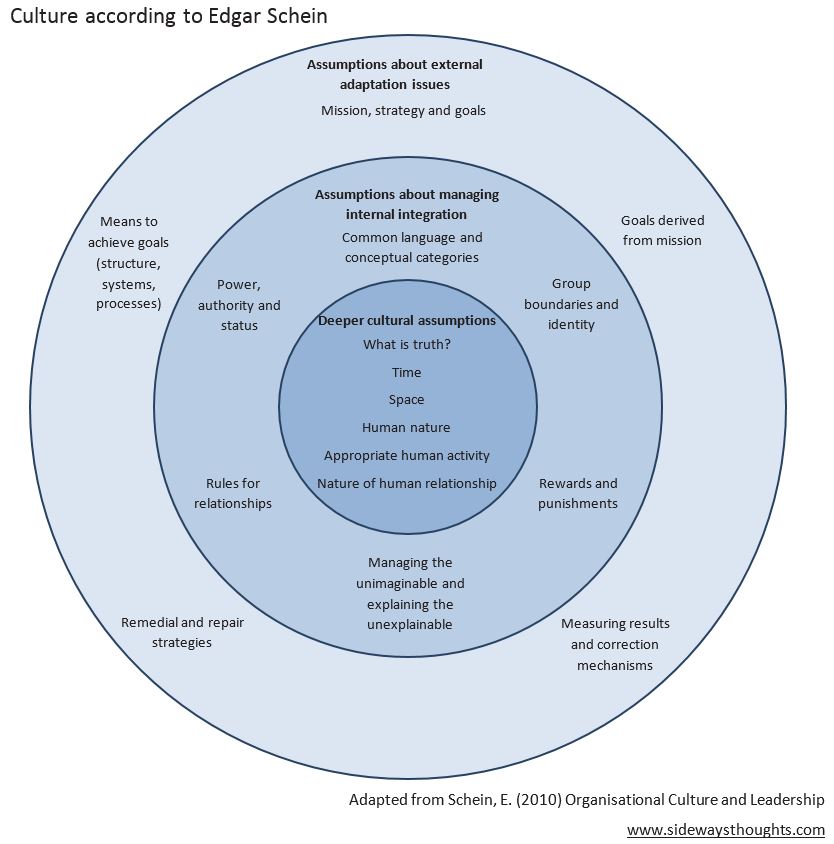Organisational culture defined, courtesy of Edgar Schein
I hear people referring to the culture of a place as being “good” or “bad”, managers and consultants speak of changing culture, and employees speak of being part of culture. What is this culture they all refer to? My studies introduced me to Edgar Schein’s answer, and confirm that the task of getting culture “right” is a tough target to hit.

Schein’s Culture
I have a lot of respect for Edgar Schein. The guy has a Masters in psychology from Stanford, a PhD in social psychology from Harvard, he was a captain in the U.S. Army, and has been a professor of Organisational Psychology and Management at MIT. With those credentials, I figure I can use his depiction of culture as a good starting point.
Schein presents culture as a series of assumptions a person makes about the group in which they participate. These assumptions are grouped into three levels, each level becoming more difficult to articulate and change. These assumptions can be seen through:
1) artefacts (what you experience with your senses, such as language, styles, stories, and published statements);
2) espoused beliefs and values (ideals, goals and aspirations); and
3) basic underlying beliefs (taken for granted conditions).
The Assumptions
Each assumption can have a book written about it. The bullet point summary is below:
Assumptions about external adaptation issues
- Mission, strategy and goals: Why are we all here in this organisation? What are we collectively trying to achieve? Do we even know?
- Goals derived from mission: What goals do we set as part of trying to realise that mission? Do we stick to those goals? How are they defined?
- Measuring results and correction mechanisms: How will we know if we achieve those goals? How do we measure it?
- Remedial and repair strategies: What do we do if something breaks or does not go as planned? Do we have a plan, or do we react?
- Means to achieve goals (structure, systems, processes): How do we go about realising our goals? Do we have systems and procedures in place, or do we trade on strength of personality?
Assumptions about managing internal integration
- Common language and conceptual categories: What are the common ways we use to refer to things? What is the common and agreed upon framework of communication and terminology?
- Group boundaries and identity: How do we respect each other’s and the collective group boundaries? How do we know who we are?
- Rewards and punishments: How do we reward desirable behaviour and punish behaviour deemed unacceptable?
- Managing the unimaginable and explaining the unexplainable: When things happen we cannot explain, what is the group response?
- Rules for relationships: What are the rules for how we interact with each other and with those outside of the group?
- Power, authority and status: How do we determine what gets done and who has the right to change direction?
Deeper cultural assumptions
- What is truth: What is the reality of the situation? How do we know what is really happening? Is it because someone says so, because everyone agrees, or because we all prove it to be so?
- Time: Is time linear, in that things only happen sequentially, or does everything happen at once? If something needs to be done, can it be done immediately in parallel with everything else, or only after current tasks are done? Can work be interrupted?
- Space: How is everyone situation? How is the work environment laid out? Is there a point when someone is invading personal space, or is intimacy generally accepted?
- Human nature: Are people only there to get work done, or are people complex individuals more than their position?
- Appropriate human activity: Are we here to take control of our environment, are we here as a slave to circumstances to simply coexist with our environment, or do we develop ourselves to work in harmony with our environment?
- Nature of human relationship: Are we individuals or are we a collective? Do we see ourselves as a group or as individuals? What is the greatest gap of power distance between ourselves?
Changing culture
With so many facets, you can see why changing culture is such a challenge. Culture is a protective mechanism. Each assumption works in collaboration to reinforce and support the other assumptions. You try and change one in isolation, the other assumptions have a propensity to reinforce established behaviour.
The assumptions are also driven by the individuals or groups who have influence within the organisation. If you want to change the culture, you frequently have to change the leaders, either in their character or physically replace them. The former is often so hard that the latter is the only option.
If you are in a management or leadership role, you need to be able to take a step back and jot down how your organisation reflects each of the assumptions mentioned above. Just be aware that your response will be tainted by your own influence on that culture. This is where the value of an external unbiased perspective can be valuable.
Culture is something we all experience but have difficulty defining. Hopefully, this helped provide a model to explain why we do what we do when we get together for common goals.


Hi!
I know you have not written in this blog for some time but I wanted you to know that it was very helpful as I work on my dissertation on culture and change. I’m writing a case study on the re-framing of culture after an academic unit moves from one building to another. Thank you for putting this together. As I reach the end of this dissertation I am needing a good breakdown of Schein’s aspects of culture and this fit the bill.
Best to you.
Joy
Hi Joy,
Thank you for your feedback! You raise an interesting perspective. I would be interested in your views on how physicality affects culture.
I have seen organisations exhibit what was described as a negative culture before a move into a new location. The action of the move, the new surroundings, and improvements in work flow resulted in a significant lift in culture. However, the affect was temporary. If the primary contributing factors to culture do not change at the same time as the move, the culture is likely to go back to what it was.
I look forward to reading you findings!
Chad
Hi Chad,
I am hoping to use your diagram of Edgar Schein’s theory of organizational culture for a Grad. School paper. Hope to hear from you!
Charles (From Spokane)
Hi Charles from Spokane,
Use away! Freely receive, freely give. 🙂
Chad from Seattle now in Brisbane after stopping off in Connecticut, San Diego, Bremerton, San Antonio, Melbourne, and Bendigo.